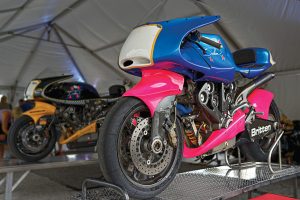
By: Dr Urie Bezuidenhout PhD (Eng), MSc (Eng), NHDip (Eng), NDip (Eng)
Director
Da Vinci Transport Planning Ltd
Rider advice
SMIDSY (Sorry Mate I Did Not See You) is a real issue that we as riders are mostly on the receiving end of. Humans are fallible beings, and research shows that our visual system evolved to accurately track objects at around 20 km/h, moving across our field of vision, not coming towards us. So as humans, we are terrible in judging speed accurately when an object is coming towards us and moving faster than the evolutionary 20 km/h speed limit.
I think there are a few things riders can do to reduce the risk of these silly crashes that occur when the driver looks in your direction, and then turns out in front of you like you are invisible. The same visual flaw is responsible when you are rear-ended sitting behind a queue of vehicles. If we understand a few of our visual limitations, then we can develop strategies to counter the flawed system.
Flaw #1: Your eye and brain can only accurately process a focal area the size of your thumbnail held at arm’s length per fixation. The surrounding field of view is made up of visual memory recall of previous fixations with the accuracy rapidly deteriorating over the next few seconds. The figure below is a computerised representation of your foveal focus (yellow circle) and how the accuracy deteriorates further from the central 1º field of view.

Flaw #2: When you move your eyes to another fixation point, you are functionally blind to any objects that appear during that transition to another point, this is called saccadic suppression. What the brain does to compensate is to fill in gaps in your panoramic visualization based on what you saw earlier and our rather poor visual memory. That’s why magicians can fool you with sleight of hand, and why you do not notice blinks or blurs when you move your eyes.
The figure below illustrates an experiment where more than 80% of pilots who landed a simulated plane using only a heads-up display (HuD), completely missed the plane taxiing in the foreground. The same problem occurs with a driver is focussing on a larger vehicle in the background, and missing a target in the foreground (O’Regan, J. K. and A. Noë, 2001).

Flaw #3: Our colour perception is strongest towards the forward views and more grayscale towards our peripheral vision, and the reason you don’t notice it is because of the trick your brain is playing to make things uniform from memory. This trait evolved to detect threats more easily by contrasting the scenery changes using grey receptor cones in your retina, as colour masks those subtle changes. Also we detect flickers much easier in our peripheral field, probably evolved to detect a predator lying in the long grass twitching its ear. We also focus our very limited field towards the biggest threat, like a large beast barreling down on you and ignore smaller and even faster-moving targets, as they are of lesser importance. If you remember those few things you can adapt your riding to stay intact.
So how does this translate to riding and not being roadkill?
When a motorcycle rider is masked by a larger object in the background, for example, a car in front, you are functionally invisible because of the tendency of a human to focus on the larger object. Unless you do a few things…. move your arms around or flicker your brake light by squeezing and releasing the brake lever whilst stopped in a queue and a vehicle is approaching from behind.
When approaching an intersection and a bigger vehicle is driving behind you, a turning driver will:
(a) fixate on the larger background threat, and a motorcyclist becomes invisible because of the smaller target and blending of colours rather than peripheral field grayscale contrasts.
(b) even if a driver spots you, your approach speed will be judged slower or similar to the larger target. When you are in front of a queue and accelerating away from the platoon, towards a turning vehicle threat, you are increasing your risk of becoming toast.
So as you are pulling away from the front of a stream of vehicles in urban areas use your passing beam to flash the opposing car, or weave slightly in the lane to make yourself more detectable… As otherwise drivers are more likely to turn across your path, and you’ll become another SMIDSY statistic.
When lane-splitting, you are wearing an invisibility cloak unless you give drivers in front of you the opportunity to detect you in a rearview mirror. We know from studies that drivers scan mirrors for less than 0.8s in a cycle of around every 6 seconds. Hence the need to keep slow passing speeds when lane splitting as it reduces the surprise for both parties. The lower your speed, the greater chance of being seen in the rearview mirror during the driver’s mirror scan.
Don’t swap two or more lanes and then attempt overtake manoeuvres within 4 seconds, as a driver won’t have seen you since the last time they scanned their mirrors to detect surrounding vehicles. If you appear in the spot they earlier identified as clear because you are belting fast across multiple lanes…. Don’t cry for me Argentina will be played at your funeral.
Remember that humans are fallible, our visual system is tuned to tracking prey at 20 km/h, and we detect flashes of light more than steady bright objects, or loud pipes.
Speaking of loud pipes, humans can accurately locate and judge the closing speed of a steady increasing sound source, but if the sound varies in pitch and tone and reflects off and masked by other objects such as surrounding cars, or comes from behind, it becomes very difficult to locate. So riding on- and off the throttle, rev-bombing everyone does not improve your chances of being seen. What you are doing is camouflaging yourself by distracting drivers. They are now spending too much time turning their heads and their eyes away from a mirror, in an attempt to locate the source, instead of paying attention to driving and scanning for hazards, such as approaching bikes.
Dr Urie Bezuidenhout PhD, University of Auckland and Da Vinci Research.

(Photo credit to CLMINTIEPIX)


